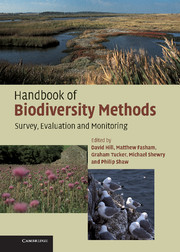Book contents
- Frontmatter
- Contents
- Preface
- Acknowledgements
- Part I Planning
- Part II Habitats
- Part III Species
- 9 Introduction to species assessment
- 10 General principles and methods for species
- 11 Fungi
- 12 Lichens
- 13 Bryophytes
- 14 Aquatic macrophytes and algae
- 15 Vascular plants
- 16 Dragonflies and damselflies
- 17 Butterflies
- 18 Moths
- 19 Other terrestrial invertebrates
- 20 Aquatic invertebrates
- 21 Fish
- 22 Amphibians
- 23 Reptiles
- 24 Birds
- 25 Bats
- 26 Other mammals
- Appendix 1 Monitoring and reporting obligations under international conservation agreements
- Appendix 2 Relationship between BAP Priority Habitat and Broad Habitat categories and Habitats Directive nomenclature
- Appendix 3 Annotated list of key references for plant identification
- Appendix 4 Determining appropriate quadrat size for vegetation sampling
- Appendix 5 The relocation of permanent plots
- Appendix 6 Equipment required for undertaking different types of survey
- Recommended sources of further information
- References
- Glossary
- Index
13 - Bryophytes
Published online by Cambridge University Press: 01 September 2010
- Frontmatter
- Contents
- Preface
- Acknowledgements
- Part I Planning
- Part II Habitats
- Part III Species
- 9 Introduction to species assessment
- 10 General principles and methods for species
- 11 Fungi
- 12 Lichens
- 13 Bryophytes
- 14 Aquatic macrophytes and algae
- 15 Vascular plants
- 16 Dragonflies and damselflies
- 17 Butterflies
- 18 Moths
- 19 Other terrestrial invertebrates
- 20 Aquatic invertebrates
- 21 Fish
- 22 Amphibians
- 23 Reptiles
- 24 Birds
- 25 Bats
- 26 Other mammals
- Appendix 1 Monitoring and reporting obligations under international conservation agreements
- Appendix 2 Relationship between BAP Priority Habitat and Broad Habitat categories and Habitats Directive nomenclature
- Appendix 3 Annotated list of key references for plant identification
- Appendix 4 Determining appropriate quadrat size for vegetation sampling
- Appendix 5 The relocation of permanent plots
- Appendix 6 Equipment required for undertaking different types of survey
- Recommended sources of further information
- References
- Glossary
- Index
Summary
Surveying and monitoring bryophytes poses considerable problems. Most are so small and difficult to identify that anything other than qualitative or at best semi-quantitative data is time-consuming and expensive to acquire. Some species are difficult to identify even for specialists, and some always require confirmation with a microscope. Working with bryophytes takes longer than working with most vascular plants. Many species grow in association with other species, and trying to quantify the amount of a target species can easily cause considerable damage to the habitat.
There are very few published studies on surveying and monitoring bryophytes in Britain. Most monitoring has consisted of merely checking that species are still present, with only limited attempts at recording population size.
A feature of some bryophytes is that they may be strongly associated with other plant species. This is obviously true with epiphytic species (e.g. Orthotrichum obtusifolium, which only occurs on trees with nutrient-rich bark) or Jamiesonella undulifolia, which is restricted to Sphagnum hummocks.
ATTRIBUTES FOR ASSESSING CONDITION
Presence–absence
Monitoring of bryophytes has in the past concentrated upon establishing that a species of interest is still in existence on sites where it has been previously recorded. Presence–absence in a series of samples (e.g. quadrats or transects or individual host plants for epiphytic species) can be used to establish frequency and to generate broad distribution maps for target species.
Population size
Semi-quantitative or quantitative methods will involve some measurement of extent.
Information
- Type
- Chapter
- Information
- Handbook of Biodiversity MethodsSurvey, Evaluation and Monitoring, pp. 288 - 294Publisher: Cambridge University PressPrint publication year: 2005
